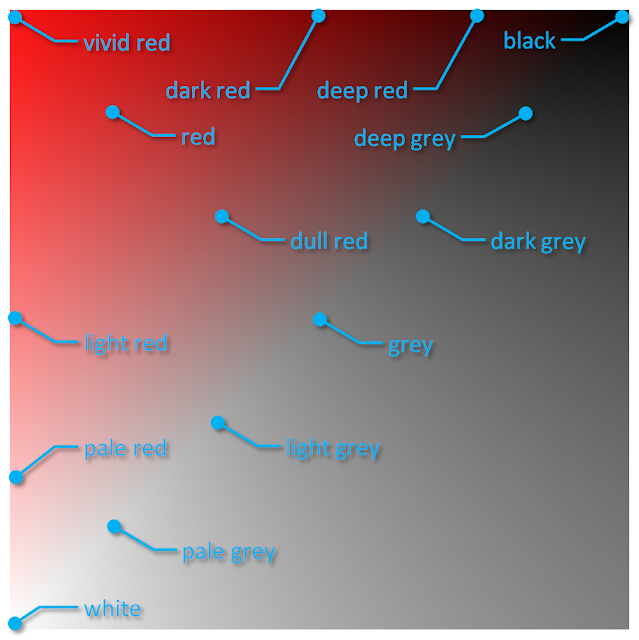Some more colour naming experiments...
After creating the RGB-125 palette (one-word names for colours based on five levels each of red, green and blue), I limited the number of levels to 64 (4x4x4). This is similar to the EGA source palette.
The EGA palette uses the adjective "bright" to describe colours with any channel at 100% intensity. This idea is mirrored in the "vivid" modifier of the ISCC-NBS system and Color Naming System. I thought that "bright" could be confused with "light", so I chose "vivid" as the prefix for any RGB-64 colour that has maximal chroma.
RGB-64 has 39 base colour names ("amaranth", "amber", "apple", "aquamarine", "azure", "black", "blue", "bluebell", "brown", "celeste", "cerise", "cerulean", "chartreuse", "cyan", "denim", "erin", "green", "grey", "harlequin", "inchworm", "jade", "liberty", "magenta", "mauve", "milan", "mint", "olive", "orange", "orchid", "pink", "plum", "poison", "purple", "red", "spring", "tradewind", "violet", "white" and "yellow") and 3 modifiers ("dark", "light" and "vivid"). The bold names correspond to the eleven (contentious) basic colour terms.
RGB-27 is a strict subset of RGB-125 covering 3x3x3 colour points. Unfortunately, we lose "brown" and "pink" in the process.
At this point, I turned my attention to limited, hue-based colour naming schemes.
HSL-79 is a scheme based on the HSL colour space. The hue (an angle between 0 and 360 degrees) is split into 12 equal segments:
- red
- orange
- yellow
- chartreuse
- green
- spring
- cyan
- azure
- blue
- violet
- magenta
- rose
- deep (very low lightness)
- dark (low lightness)
- light (high lightness)
- pale (very high lightness)
- dull (low saturation)
- black
- deep grey
- dark grey
- grey
- light grey
- pale grey
- white
HSV-79 is similar but based on the HSV colour space instead of HSL. I tried to parameterize the partitioning of the segment so that each contains approximately the same number of RGB (256x256x256) colour points.
 |
| HWB-91 reference points for a given hue (x-axis is blackness, y-axis is whiteness) |
The numbers in the final column are the ΔE*(2000) colour differences between "#FFCCFF" and the nearest colour from the discrete palette.


No comments:
Post a Comment